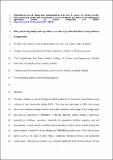| dc.contributor.author | Shi, W. | |
| dc.contributor.author | Healy, Mark G. | |
| dc.contributor.author | Ashekuzzaman, S.M. | |
| dc.contributor.author | Daly, K. | |
| dc.contributor.author | Leahy, J.J. | |
| dc.contributor.author | Fenton, Owen | |
| dc.date.accessioned | 2021-06-28T11:46:28Z | |
| dc.date.available | 2021-06-28T11:46:28Z | |
| dc.date.issued | 2021-06-22 | |
| dc.identifier.citation | Shi, W., Healy, M. G., Ashekuzzaman, S. M., Daly, K., Leahy, J. J., & Fenton, O. (2021). Dairy processing sludge and co-products: A review of present and future re-use pathways in agriculture. Journal of Cleaner Production, 314, 128035. doi:https://doi.org/10.1016/j.jclepro.2021.128035 | en_IE |
| dc.identifier.issn | 0959-6526 | |
| dc.identifier.uri | http://hdl.handle.net/10379/16831 | |
| dc.description.abstract | The dairy industry is one of the largest global producers of wastewater and generates huge volumes of dairy processing sludge (DPS). There are two main types of DPS, lime-treated dissolved air floatation sludge and bio-chemically-treated activated sludge. These sludge types may also be converted to STRUBIAS (STRUvite, BIochar, AShes) products which have potential as fertilizers, secondary feedstocks for phosphate fertiliser granules, and soil amendments. A small number of studies indicate that these products have variable nutrient and metal contents, which differ across sludge and STRUBIAS product types. This is due to many factors such as the type of dairy plants, wastewater treatment process and production technologies. Although such products are commonly applied to land, their phosphorus (P) and nitrogen (N) fertilizer equivalency values (FEV) are understudied at field scale. Their contaminants including heavy metals, antimicrobial drugs, hormones, pesticides, disinfectants, persistent organic pollutants (POPs), microplastics and nano particles require quantification, as do their impact on soil and plant materials, and potential environmental impacts. This review concluded that while DPS and STRUBIAS products have potential in nutrient recycling, their uncertain plant-available nutrient content and the potential presence of emerging contaminants make them difficult to be used efficiently. Future research should focus on the characterisation, fertilising effects, environmental risks and the production technologies across all types before they can be a marketable fertiliser product. | en_IE |
| dc.description.sponsorship | This project has received funding from the European Union's Horizon 2020 research and innovation programme under the Marie Skłodowska-Curie grant agreement No 814258. | en_IE |
| dc.format | application/pdf | en_IE |
| dc.language.iso | en | en_IE |
| dc.publisher | Elsevier | en_IE |
| dc.relation.ispartof | Journal Of Cleaner Production | en |
| dc.rights | Attribution-NonCommercial-NoDerivs 3.0 Ireland | |
| dc.rights.uri | https://creativecommons.org/licenses/by-nc-nd/3.0/ie/ | |
| dc.subject | Dairy processing sludge; agriculture | en_IE |
| dc.subject | emerging contaminants | en_IE |
| dc.subject | phosphorus recovery | en_IE |
| dc.title | Dairy processing sludge and co-products: a review of present and future re-use pathways in agriculture | en_IE |
| dc.type | Article | en_IE |
| dc.date.updated | 2021-06-28T10:41:18Z | |
| dc.identifier.doi | 10.1016/j.jclepro.2021.128035 | |
| dc.local.publishedsource | https://doi.org/10.1016/j.jclepro.2021.128035 | en_IE |
| dc.description.peer-reviewed | peer-reviewed | |
| dc.contributor.funder | Horizon 2020 | en_IE |
| dc.internal.rssid | 24732526 | |
| dc.local.contact | Mark Healy, Room Eng-1038, Civil Engineering, Col Of Engineering & Informatics, Nui Galway. 5364 Email: mark.healy@nuigalway.ie | |
| dc.local.copyrightchecked | Yes | |
| dc.local.version | ACCEPTED | |
| dcterms.project | info:eu-repo/grantAgreement/EC/H2020::MSCA-ITN-ETN/814258/EU/Phosphorus REcovery for FertiLisers frOm dairy processing Waste/REFLOW | en_IE |
| nui.item.downloads | 194 | |


